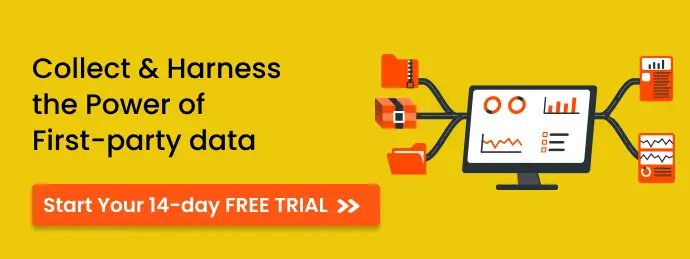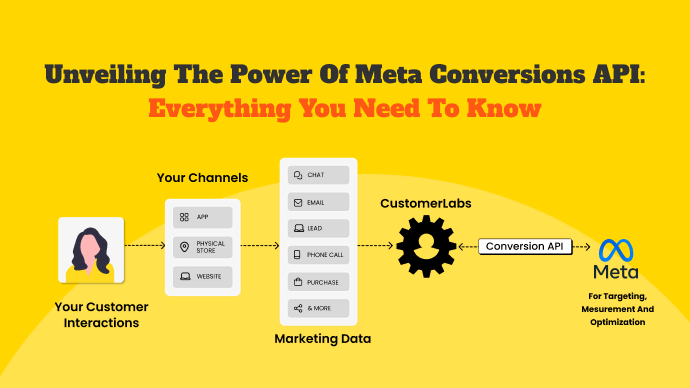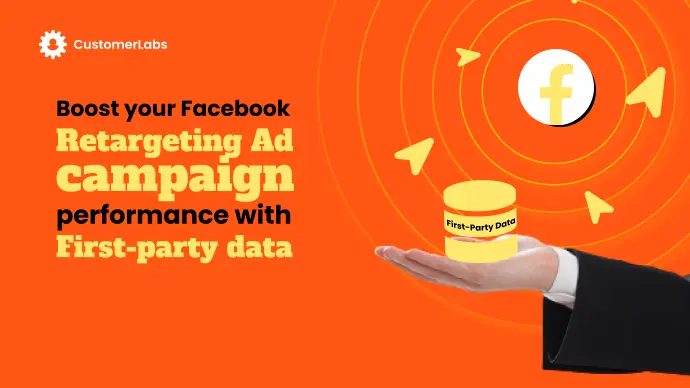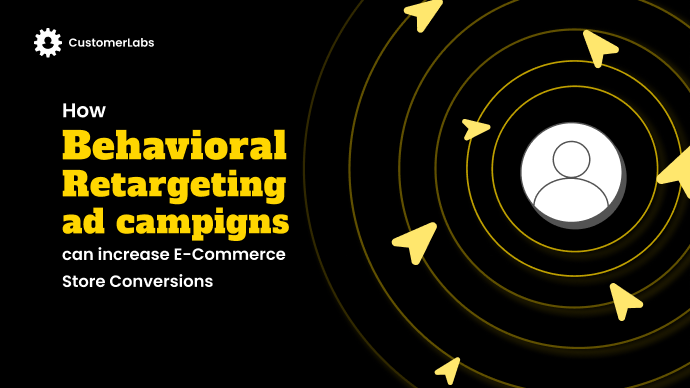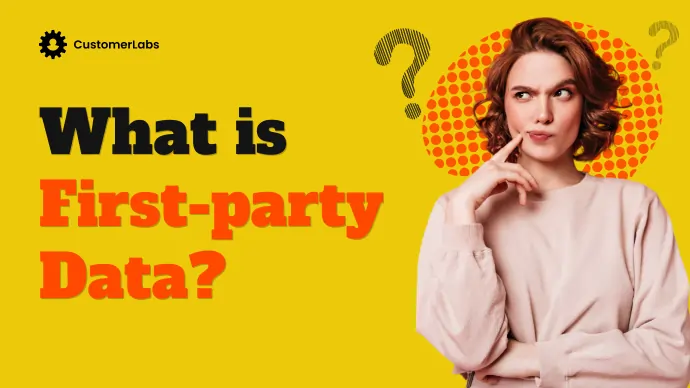
The buzzing term among all businesses after the emergence of data-privacy regulations across the world is ‘First-party data’ or the ‘1PD’. Every industry – offline or online – is shifting its focus to first-party data for various reasons – primarily because it gives information about the customer directly.
Making the best use of first-party data is totally dependent on the marketing teams.
In this blog, we will comprehensively cover
- What is first-party data
- How to collect first-party data
- The importance of first-party data in marketing
- How first-party data helps
- How to leverage the immense potential of first-party data
- Using first-party data effectively for
- Google Ads – including Performance Max Campaigns
- Meta Ads – also for Meta Advantage+ Campaigns
- Case studies & Use cases of First-party data
Let us dive in to know everything from scratch one by one and get detailed information about first-party data & first-party data strategy, a cue card for the cookieless world to offer personalization to your users & prospective customers!
What is First-party Data?
First-party data (often referred to as ‘1p data’ or 1PD)- as the name suggests, is the data collected by the organizations from the user directly. However, the recent First party data activation playbook by ThinkWithGoogle highlights another aspect to 1p data – Business data.
First-party data comprises the following data collected by businesses themselves:
- Demographic data
- Location
- User purchase data
- Personal data such as name, email, IP address, contact number, social media handles, etc. (Social Media Conversations & CRMs)
- Consumer feedback & interest through surveys and other forms
- User behavior on your website, app, or product
And, it comprises the following data of the businesses:
- Business goal
- Profit
- Revenue
- Conversion Data
- Store location data
- Margin
- Stock level
The First-party data collected from the users is of two types –
1. Known user data
Demographic data, location, purchase data, personal information, etc., come under known user data. Of the website users, the logged-in users’ data is the known user data and is easily available for the marketers to leverage it.
The Known users are just 2% of the entire website visitors
2. Anonymous user data
And the unregistered website visitor data is known as anonymous user data.
In general, 98% of website visitors are anonymous, and collecting those users’ behavior data is nearly impossible after the data privacy updates such as the iOS14, restriction of third-party cookies, etc.
The entire website visitors behavior is what gives the user behavior data with complete customer journey which can be called as the real first-party data.
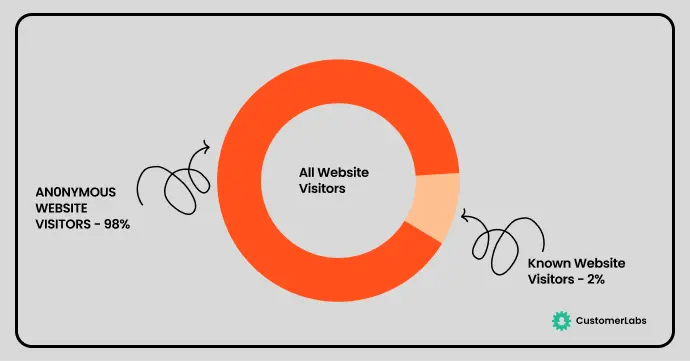
Different types of Data:
There are four different types of data. In addition to the first-party data, you have second-party data, third-party data and the recent buzz, the zero-party data.
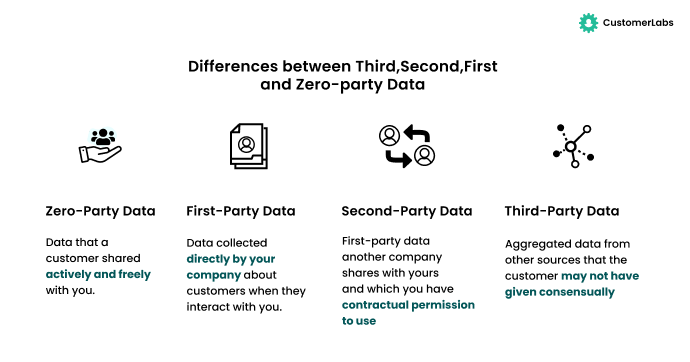
Zero-party data: If a customer proactively shares their data about their personal preferences, tastes, likes & dislikes, to a business, that data is called as zero-party data.
Second-party data: The data exchanged between two businesses in the similar niche through a partnership. The customer might or might not be aware / informed of the data shared between the two businesses.
Third-party data: The data collected by the data aggregators and sold to other businesses is the third-party data. The customer whose data is being sold is mostly unaware of where their data is being shared and used.
What is the source of first-party data?
In the current era, you can see that every user interacts with a single business through various touchpoints online and offline platforms. A customer’s journey is not at all linear. It is a web of complex behaviors. Only when a business understands all of this and offers a smooth personalized experience, a user becomes a returning customer.
The primary benefit of all these touch points is – the data is provided by the customers themselves. But where do you actually find the data? Most likely, below are the places where you can collect the data:
1. Website:
Your website is the primary source of all first-party data or the 1PD that you can rely on. From user behavior, and actions to IP address, email address & phone number, you can collect all the data when a user lands on your website.
2. Mobile Web:
The mobile web is similar to the website and allows you to collect all the first-party data. However, with iOS14+ & the soon-to-come Android14 updates, it is difficult to collect user behavior data on the mobile web. And to overcome this problem, you can rely on a 1PD Ops like CustomerLabs that collects the data on the server side.
3. Apps:
Mobile apps have seen a spike in popularity in the last few years and users prefer mobile apps compared to a website as it offers more personalization and is more user-friendly than a website. A mobile app offers more data parameters such as an email address, phone number, etc., as you can have the users logged in to the app to use it. And it is seen that the probability of a user logging into an app is more compared to the user logging on to a website. Therefore, if you have an app, you are most likely to get complete customer data without much effort and it is your own data that stays with you forever!
4. Email, SMS & Messaging Platforms:
Email marketing dates back to the first phase of digital marketing where you get to know who is opening your emails, and who has shown interest in the email you sent. Now you have customer behavior data and how they interact with your brand, which is again first-party data. With WhatsApp API out, many marketers have shifted their focus to collecting data even from WhatsApp interactions. This gives you better first-party data behavior. Text messaging service is a pivotal tool for collecting first-party data, as it allows businesses to directly engage with customers, track their interactions, and gather valuable insights into their preferences and behaviors.
5. Point of Sale (PoS):
This is an offline source as it is the data you can collect at the point of sale of your retail store. It gives information on how a certain user interacts with your brand offline, their feedback on your service, product, etc. This data is precious and you should harness it quickly as you know what a user is interested in buying, what they are not, and where they are buying from. No other company has this unique data that you get from your customer directly. Using offline conversion tracking, you can sync this data continuously.
6. Customer Support Center:
If there’s any place you can also get to know about not just the happy customers but also the problems a customer face. Now, if you collect this data from the support center, you can easily understand the user behavior and enhance their experience to help them make better decisions. This can be the perfect source to add to the existing customer behavior data you have gained through all the other above sources.
How to collect first-party data?
There are multiple ways to collect 1PD or first-party data both offline and online.
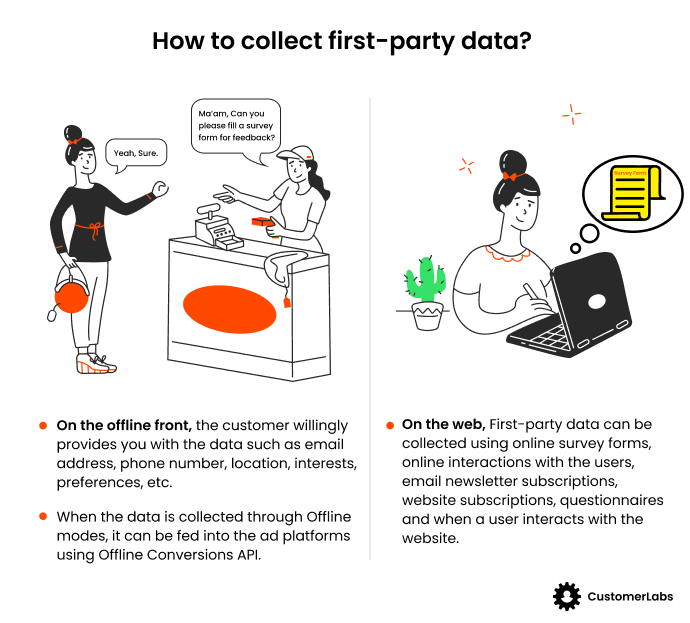
The best way to collect first-party data (including anonymous website user behavior) is by using a real-time 1PD Ops Platform (1PD Ops) like CustomerLabs because you can collect both known and unknown user behavior data. When you collect your 1P data using an advanced next-gen 1PD Ops, you can store the data efficiently, segment it as per your choice and sync it with ad platforms to run personalized ads & leverage its power.
Most advertisers are exploring cookieless tracking solutions to collect first-party data. Server-side tracking using cookies set by the own domain is the go-to for collecting 1p data.
Use Fusion, our advanced feature to collect first-party data across multiple platforms – online, and offline (CRM, PoS, In-store, offline events, etc.). Unique advantage of fusion is to collect the first-party data from the server side. And rather than calling it as cookieless advertising or cookieless tracking, we address it as CONSENTED FIRST PARTY DATA.

How is first-party data different from second & third-party data?
First-party data or 1PD, as mentioned above is the original data directly collected from the users while the other types of data – the second-party & third-party data are not given directly to the brand by the user.
Second-party data:
Second-party data is nothing but the first-party data of a company exchanged with another company through a partnership or purchase.
To understand better, let us see an example. An eCommerce brand that sells clothing, can partner with another brand that sells footwear. Now, the data shared with other companies is called second-party data. Second-party data benefits you as a marketer as you can reach out to top-funnel (ToFu) customers that are highly prospective.
To comply with strict guidelines for data privacy & data sharing, it is recommended to not to share the data with another brand as per latest privacy regulation laws.
Third-party data:
Third-party data is the data sourced from a third party data vendor, a data aggregator who sells data in exchange for monetary compensation. The data is aggregated from various sources and is segmented based on interests, category, demography, etc.
Sometimes, the data also consists of PII (personally identifiable information), and sharing or storing of PII is restricted under GDPR, CCPA, etc.
Who does first-party data benefit?
Stepping ahead into the future of marketing, every business that runs ads will need 1P data. Some of the industries that are benefiting from first-party data are:
- eCommerce
- SaaS (Software as a Service)
- B2B businesses
- Digital Marketing Agencies (marketers)
- Retail
- Real Estate
- Hospitality industry including hotels, resorts, etc.,
- FMCG
- Corporates
- Fashion & Beauty
- Hospitals
- Agriculture
- Personal Businesses
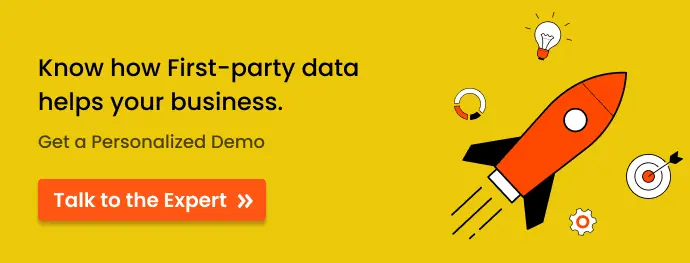
Why is First-party data the need of the hour?
Until the release of various data privacy updates including Apple’s iOS14+, the data was collected by third-party browser cookies and pixels of numerous ad platforms such as Meta, Google, etc.
Google & Meta faced audience signal loss due to unavailability to access user data because of these data privacy updates.
Now, with restrictions to third-party cookie tracking, and because of Apple’s App Tracking Transparency framework, it is difficult for the ad platforms to effectively collect the data, and store it to run ad campaigns. All these led to the decline of ad campaign performance beyond anyone’s imagination causing doldrums in the hearts of marketers.
It is high time that you realize the importance of first-party data and start collecting it now. Once you collect first-party data and sync it with Google & Facebook, audience signal loss is minimized to a great extent leading to high-performance ad campaigns.
Google has reiterated by saying “Leverage audience signals from your first-party data to reach similar audiences and run your ad campaigns effectively”
The recent report published on November 21, 2024 by Shopify titled “Seeing Around Corners: Personalization” reinforces about first-party data being the future of advertising.
Leverage the power of First-party Data (1PD): 1P data Activation
The true power of first-party data is realized only when you know how to leverage it to its full potential and activate this data across channels where your customers exist.
Understanding Audience Behavior:
When you analyze the first-party data (1PD), you can easily understand the various touch points of your customer and how they behaved on your website. Once you have this data, you can utilize its full potential by segmenting the users based on their similar behavior and run ads.
Here comes an interesting thing – Explore the Power of Behavioral Retargeting.
Now, what is Behavioral Retargeting?
Behavioral Retargeting is the strategy to retarget the user based on their behavior on the website/app or interaction with the brand. It works very well because you can deliver personalized ads to all your users, bringing them close to making a purchase.
Behavioral targeting strategy also helps you improve conversions through cross-selling and upselling techniques, boosting the trust of a customer in your brand.
Understand how behavioral retargeting strategy works to increase your eCommerce Conversions by 2X times! – Read More about Behavioral Retargeting Strategy
Predicting the User Behavior:
First-party data helps you understand, analyze and come up with a pattern for user behavior. Now, when you closely observe the data, you can predict the most probable action a user might take in the future. Understanding the customer journey is only possible when you have access to the accurate user behavior data, i.e., the first-party data.
Personalization:
Every user has various touch points & sources. A customer can once come from a desktop and then later from their mobile phone. When you capture all of this data at one place, you can personalize the users’ experience across all platforms. When you collect the first-party data using a 1PD Ops like CustomerLabs, you can stitch the entire customer journey to get a 360-view of the customer and therefore offer better personalization to the user.
Accurate & Reliable Data:
You own the first party data because you collect the data by yourself. Therefore you can be sure of the quality of the data. First party data is the most accurate and reliable data. Also, the first-party data you collect is in compliance with the data privacy regulations such as the CCPA, GDPR, etc.
Nurture the Existing Customers:
First-party data helps you to nurture existing customers by retargeting them with relevant personalized advertisements. Thus, increasing the Lifetime Value (LTV) & Average Order Value (AOV).
Perfect Lookalike Audience:
Ad platforms have been reiterating again and again to collect first-party data and sync it with them. The primary reason behind the ad platforms asking so is, when you send across rich first-party data, the algorithm train itself and comes up with a lookalike audience similar to the custom audience that you submit in the form of first-party data.
So, even to enhance your broad reach campaigns using the lookalike audience, you need to provide better quality first-party data. To collect and sync rich first-party data without any audience signal loss, you need a real-time 1PD Ops platform, that has tools like fusion.
Once the data is collected, processed, and segmented, the next mandatory step to activate this data would be – sending it across Google Ads, Meta Ads, LinkedIn Ads, WhatsApp marketing, email marketing and more.
How first-party data helps improve your Google Ads performance?
The evolution of Google Ads has shown how it is moving a step closer to automation every day. And after the recent release of Performance Max Campaigns (PMax), it is evident that Google Ads is moving towards the era of automating the ad campaigns.
Thus, less work for the user to think about coming up with strategies for the defined goals.
With the release of PMax, the only thing the users have to do is set up a goal – conversions, leads, website traffic, or any other thing.
Google has emphasized the importance of First-party data and how 1p data helps its algorithms learn better about your audience. The trained ad algorithms work to increase your ad reach & Click-through-rate (CTR) by targeting the perfect audience. For the automated smart bidding campaigns to work, the right audience signals matter. Sharing the right audience signals through 1p data to Google Ads will boost the ad targeting accuracy. Further leading to better conversion rates.
Personalized advertisements will be shown to users across Discover, Search, Maps, Gmail, YouTube & Google’s Ad network with Google Ads.
Also learn how to use first-party data to reduce RTO
Google Seeks More First-party data…
Google’s ad platform seeks high-quality audience signals(first-party data) to help its algorithm learn about your users’ behavior and then retarget audiences based on that data. The more data, the more will be the ad campaign performance. First-party data helps Google’s Ad Platform increase its Customer Match Rate.
Our Experiment with Google Ads:
We tried an experiment with Google ads by sending in the first-party data that we ourselves collected to Google. And for anonymous users, Google has given us a match rate of around 50 to 60%. Which is really a great match. The average match rate for most marketers is between 29 and 50%.
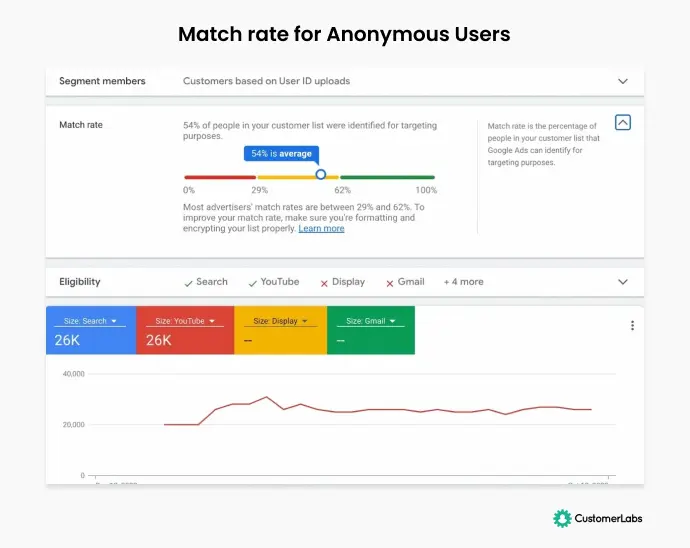
And for the known users, Google was able to give us a 100% match rate.
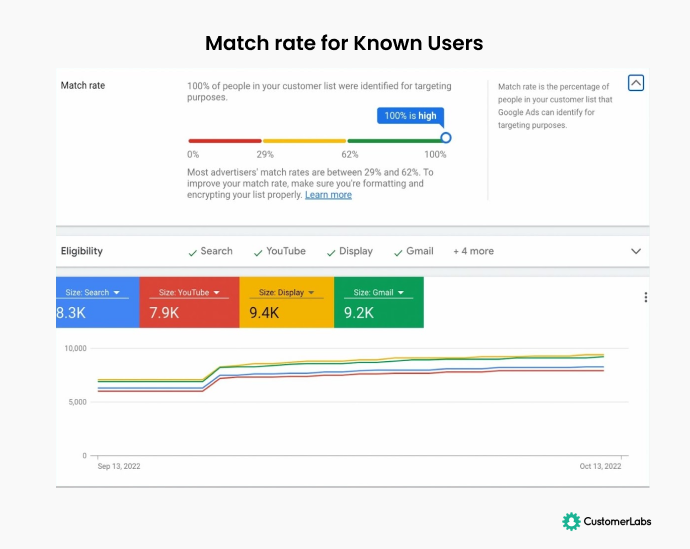
That is the power of First-party data collected with the help of a real-time 1PD Ops.
Google’s Recent Updates:
Update 1: Changes to Similar Audiences Targeting
Google also has announced that it would discontinue the ‘similar audiences’ or ‘similar segments’ feature starting May 1, 2023.
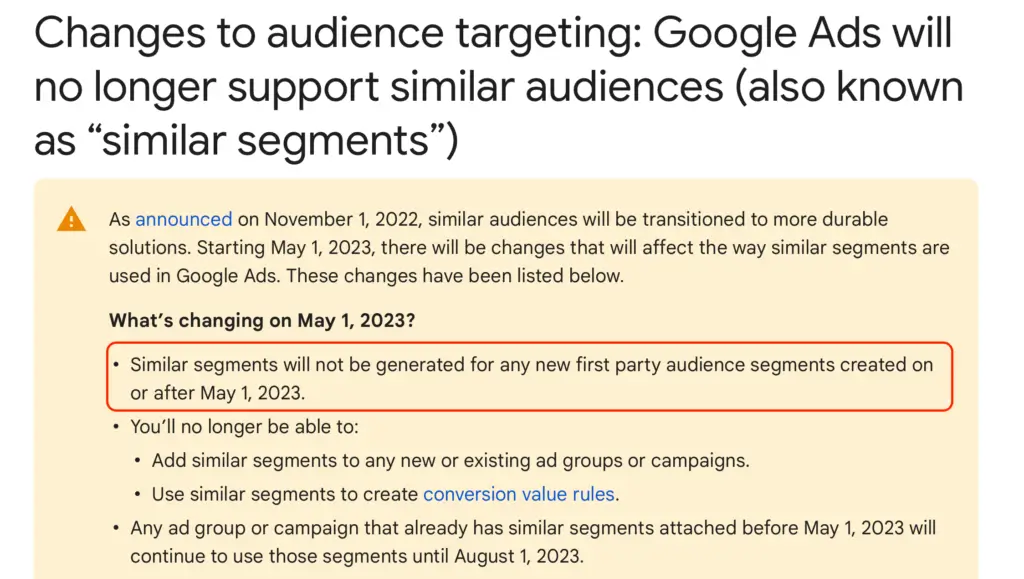
The Performance Max campaigns launched by Google recently clearly state that you should feed its algorithm with as much data as possible. This proves to be a step towards embracing first-party data.
To know more about what Google Retargeting is & how to boost your ad campaign performance despite all these hurdles, check out the comprehensive blog on Google Retargeting with first-party data.
Note: Remember? I mentioned that Offline data also is first-party data; Here’s a guide to setup Offline Conversion Tracking in Google Ads.
Update 2: Google Accepts only Consented First-Party Data if you are an advertiser in the Europe. To mitigate conversion data loss in Google Ads, you have to implement Google’s consent mode v2 the right way for your first-party data (online & offline). To know more about Google’s consent mode v2, read the blog by me, Goutham Veerabathini.
Update 3: In the Demand Gen Campaigns by Google Ads, you can leverage lookalike audiences. Therefore, sync your first-party data with Google Ads, and find lookalikes to increase your ad targeting precision in Google Ads. Here’s everything you need to know about Demand Gen Campaigns – Read the blog.
First-party data & Meta Ads:
Meta Network consists of Facebook, Instagram, WhatsApp, Messenger, and Audience Network. It offers immense potential to brands to advertise on the Meta Ads Network as it clubs necessity with advertisements.
For example, every user needs WhatsApp & Messenger for communication purposes and Instagram & Facebook for both communication & entertainment purposes. Now, every person has a dire necessity to use these applications.
Therefore, Meta Advertising offers more reach & engagement. However, with Apple’s iOS14+ updates, third-party cookies blocked from browsers & data privacy regulations, Meta is no longer your data host. And custom audience match rates dropped to below 25%!
Unlock insights: Elevate your Facebook Custom Audience Match Rates beyond 80% – Discover Now.
We tried an experiment with Meta ads by sending in the first-party data of 16000 blog visitors to Meta. And Meta was able to match more than 80% of the users. Whereas with the pixel-collected data, Meta gave us a match rate of around 25%.
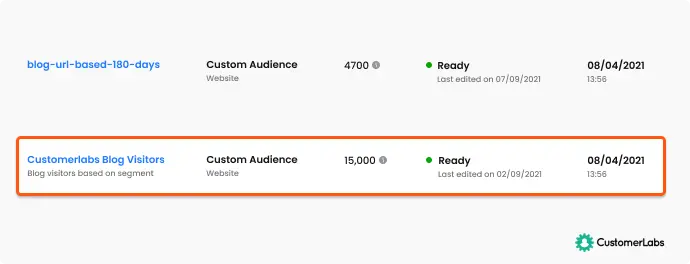
To know more about how Facebook Retargeting Strategies use first-party data, read the blog. – Boost your Facebook Retargeting Ad Campaign performance with First-party data.
1P data is the secret to win Meta Ads Campaigns
Meta’s ad algorithms are updated and they are totally powered by AI now. In one of the recent talks by Mark Zuckerberg, the founder & CEO of Meta, he says,
“Over the long term, advertisers will basically just be able to tell us a business objective and a budget, and we’re going to go do the rest for them. We’re going to get there incrementally over time, but I think this is going to be a very big deal.”
This clearly says where Meta is heading towards – complete automation. But for this to realize, Meta needs your data – high-quality first-party data trains these ad algorithms.
The learning of Meta Ads algorithm happens in 3 stages:
- Pixel-level data collection
- Account-level aggregation
- Campaign-level optimization
This will optimize the ad campaigns for targeted conversions, leading to high-quality purchases. All this will result in realized profits – the incremental revenue.
Read the full blog – The Secret to Winning Meta Campaigns: Targeted Conversions with First-Party Data + Smarter AI
Now, let’s see how Meta is stepping towards that goal slowly. The first step towards the aim is – the Advantage Shopping Campaigns.
First party data in Advantage+ Shopping Campaigns (A+SC)
Meta’s Advantage+ Shopping Campaigns are driven by AI-powered algorithms that rely on the data you input to target the audience across all of Meta’s channels like the audience network, Facebook, Instagram, Reels, Stories, etc. As Meta recommends, you need to sync your first-party data with Meta Ads through Conversions API to mitigate the audience signal loss.
When you train Meta’s algorithms with first-party data, it optimizes its audience targeting, reaching out to high-intent and high-value customers. Marketers have seen immense results when they leveraged first-party data in Advantage+ Shopping Campaigns. One such result is – 4X conversion rate!
Challenges to use first-party data:
We have seen what are the sources of first-party data and how to collect first-party data. Yet, you might still face some challenges when you decide to use first-party data.
No proper integration:
With no proper strategy, a business decides to use first-party data just because everyone is hyping about it. And they expect it to work instantly. Before even stepping into first-party data, you need to come up with a proper strategy. You should integrate all the sources of data you currently have with tools such as a 1PD Ops platform to overcome the challenge of integration.
No Real-time tracking:
Most businesses are collecting the first-party data in their servers and then later syncing it with ad platforms. One thing they forget to realize is that delayed data is equal to no quality data. Only when you have real-time data, can you analyze and act upon at the right time before the opportunity window closes.
Lack of technological advancement:
Marketers I have interacted with have mostly suggested that they lack the technology to leverage the full power of first-party data. However, one solution most of them see feasible is the First Party Data Ops platform that helps them go beyond conversion tracking, and do more with first-party data.
How digitally mature businesses are encashing the immense benefits of first-party data despite the challenges?
Google has come up with categorizing businesses into four stages based on how mature a business digitally is. And the surveys say most businesses fall under the second & third stages. Know where your business stands – Evaluate Your Digital Maturity
Now, the businesses in the third & fourth stages, i.e., the digitally matured businesses use first-party data to understand their user behavior based on the data the user gives directly. These businesses collect user behavior data in compliance with the data privacy regulations and segment them to chalk out the strategies. They also ensure to integrate all the data at one place and track the data in real-time.
The business’ marketing teams retarget the website users and increase their conversion rates by 3X times. It is evident from the case study by Google.
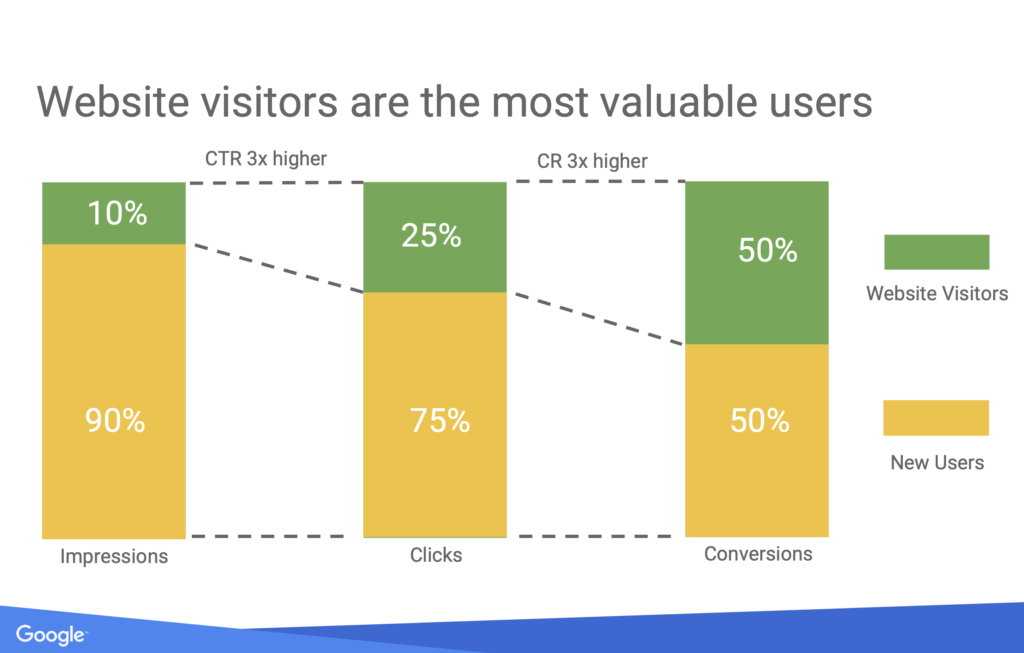
How digitally matured brands cashed the first-party data is by going a step further and collecting all user behavior on their websites/apps and using it to understand the user.
Once the user behavior is known, you can cater to the demand. Doing this helps the user make the right decision which helps them seamlessly come out of the messy middle.
First-party data use cases (1P data use cases)
Here are a few first-party data use cases that we recommended to most of our clients, only to make them see increased growth in their business to move to the next step, the next stage in Digital Maturity.
1. Advanced Audience Segmentation Strategies:
Every business is aware of the basic segmentation strategies and will follow them. And only those businesses that are in the third & fourth stages of the Digitally Maturity Model use advanced segmentation strategies by using first-party data.
Some advanced audience segments that businesses use are:
Users who:
- Have visited the page during the last Holiday season sale
- Abandoned the Cart
- Viewed a Certain product/page multiple times
- Have a high AOV
- Purchase only when the sale is available
- Make a purchase when there are discounts
To be able to use such advanced audience segmentation strategies and to be quick in reaching out to the users with a highly-personalized experience, you would need the help of a real-time 1PD Ops such as CustomerLabs.
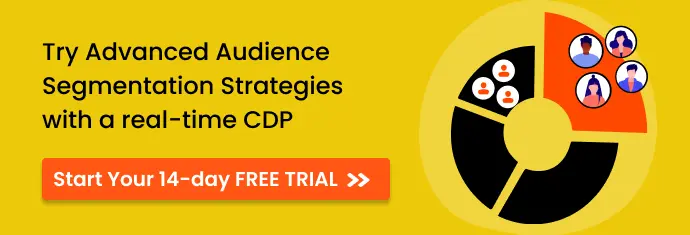
2. Advanced Event Optimization
With first party data collected using CustomerLabs, you can optimize the ad campaigns beyond the standard purchase event. Creating synthetic events with first-party data Ops platforms such as CustomerLabs is as easy as squeezing a lemon. Here are two synthetic events for your understanding on how you can leverage these synthetic events to optimize the ad campaigns to get your business needs!
AOV-based event optimization
One of the possible purchase event optimization is – for example, optimize for purchase event with AOV greater than $1000, or for AOV less than $500, depending on your business strategy.
Category based event optimization
When a business has multiple categories, and syncs the purchase event with Meta, it will see it as a purchase event as a whole but will not understand which purchasers are from which category. To optimize your ad campaigns for a specific category, you must sync the purchases related to that specific category.
For suppose, you have three categories of products – for newborns, kids, and adults. Now, when you send all your purchase event data, with an ad campaign for adults, you might also attract purchasers of newborns. Therefore, it is crucial to optimize your ad campaign with the right purchasers. It is where CustomerLabs 1PD Ops comes into picture, to utilize your 1P data effectively.
3. Smart Budgeting
Most marketers target only the top & bottom of the funnel by spending 80% of the marketing budget on the top of the funnel (ToFu) and 20% on the bottom of the funnel (BoFu).
With first-party data, you enter into data-driven marketing wherein you can use your middle funnel audience (MoFu) for retargeting. And we recommend a split of your budget into 60:30:10 for ToFu:MoFu:BoFu respectively.
It is not advisable to increase your BoFu spend beyond 10% of your budget. You can target these Bottom funnel audiences with regular Dynamic Product Ads (DPA) to convert them.
4. Mid Funnel Strategy
You can micro-segment your middle funnel audiences into – High-intent, medium-intent, and low-intent.
High-intent audiences are those who have
- Abandoned the cart in the last 15 days
- Wishlist for more than 30 days
- Viewed the product but not added to the cart
- Product viewed more than five times
Medium-intent audiences are those who viewed the product in the last 365 days, and the low-intent audiences are all website visitors who did not perform any major actions as such.
5. Omnichannel Marketing
First-party data collected from various sources gives a detailed picture of a customer journey which tells how a specific customer navigates through a website to an email to a mobile device and then again back to the desktop before making a purchase. Now, segmenting based on this behavior helps you optimize your strategies that lead to conversion.
6. For Lookalike audiences
Most ad platforms are moving toward automation and AI is doing the job of enhancing & optimizing your ad campaigns for better reach. The only thing you have to do is, give as much first-party data with relevant audiences to the ad platform. The AI trains itself on the data you provide and creates a lookalike audience to help your ads reach the right audiences.
7. Value Based Lookalike audiences
Value based lookalike audiences allows you to sync your 1PD with ad platforms along with the value they contribute to your business or with a value that they might contribute. Using the first party data with value, ad platforms’ algorithms will optimize the campaigns to find the audience that provide high value to your business. To know more about how value based lookalike audiences work, read this blog.
What do industry experts say about first-party data?
Industry experts like Google, BCG, Deloitte, Adobe, and many others have emphasized a shift toward first-party data. The primary reason is, it is more reliable. On top of that, the data privacy updates force companies to collect first-party data making access to third-party data difficult.
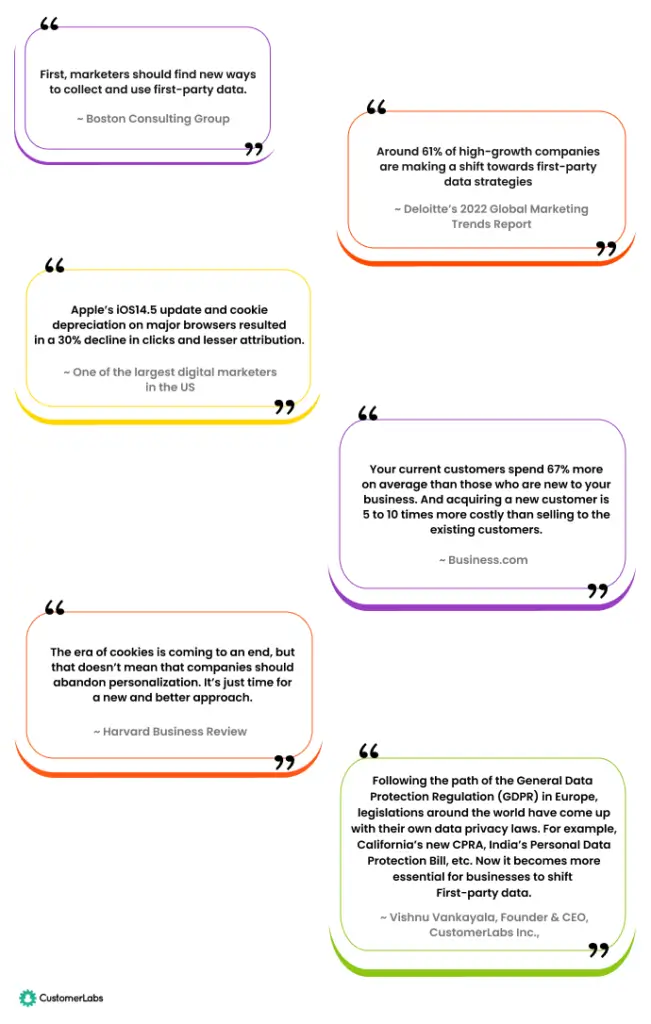
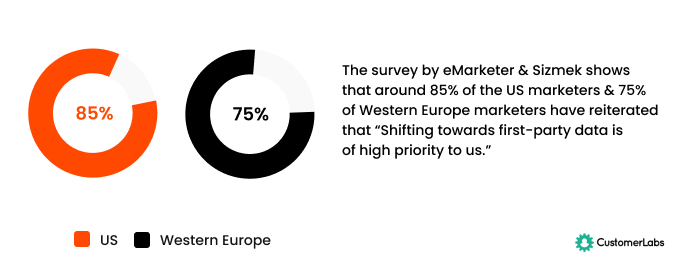
Stepping into the Future with First-party data:
By now you must have understood what exactly is first-party data and how businesses can collect first-party data to scale their marketing efforts. Some of the case studies discussed in this blog have also thrown some light on leveraging the full potential of first-party data to run advertising campaigns effectively on all ad platforms such as Facebook, Google, Bing, etc.
With the right first-party data strategies, integrate all of your data – offline & online into one place and extract full benefits from it.
First-party data can help you survive in the cookieless world & enhance your marketing efforts to reach your goals.
Whatever industry your business is into – eCommerce business, SaaS business, digital marketing agency, retail, real estate, or any other business, first-party data can be your aiding guide!
To know how you can navigate 2024 and future with 1PD, read this blog.
The Right Way To Leverage First Party Data Ops
By now, it is evident that 1p data or the first-party data is the future. Now, to leverage first-party data, you need to start with tracking your website visitor data using server-side 1P domain tracking. Once the setup is ready, you are good to go and fusion all your other first-party data sources such as CRM, Data warehouses, PoS, Subscription systems etc., with seamless integrations.
Next, automatically merge the identities using advanced identity graph technology such as Stitcher 2.0, to get a complete 360-degree view of a user.
After that, go ahead and create audience segments using Nucleus, to sync these segments into marketing platforms for personalizing user’s experience across ads and other marketing channels.
While you utilize audience segments, you can also sync all the conversion events including synthetic events to ad platforms to activate the audience and maximize your ad campaign performance.
It does not stop at this!
With your growing business, you can scale the entire system to meet your business needs, and leverage the complete power of your first-party data using this powerful first-party data Ops platform or the 1PD Ops platform.
It goes further – 1PD Ops lets you speak directly to Meta’s smarter AI systems through 1p data. For example, if you want more profit, then you must send conversion event data of those users who purchased products with higher margin, or any other strategy that you can think of.
Want to get started? Talk to our experts today by scheduling a personalized demo here!
Benefits of first-party data:
- No dependence on third parties for data
- In compliance with the data privacy regulations
- Unique data
- No one will have access to your first-party data
- Collect the data directly from the customers
- Accurate & full control of data
- Reduce the cost involved in customer data collection
- Enhance customer data integrity
- High-quality data
- Real-time customer data
- Create a 360-degree view customer profile
- Target suitable audience
- Helps personalize your customers’ experience
- Optimize your marketing strategies
- Reduce your Customer Acquisition Cost (CAC)
- Increase your Return On Ad Spend (ROAS) & Profit On Ad Spend (POAS)
And the list goes on…
Therefore, first-party data is the only savior that helps you save your ad campaigns from declining performance. It is much needed for you to act now and collect your first-party data.
It is no secret that every brand has a huge mine of first-party data but is unable to harness & leverage its power by collecting it using a 1PD Ops to sync it with Ad platforms.
You, as a marketer, can analyze customer behavior across various platforms, combine them in one place, and craft strategies for all your future marketing campaigns with first-party data.
Be wise and choose first-party data to step with success into the future of digital marketing and unleash the beast.
